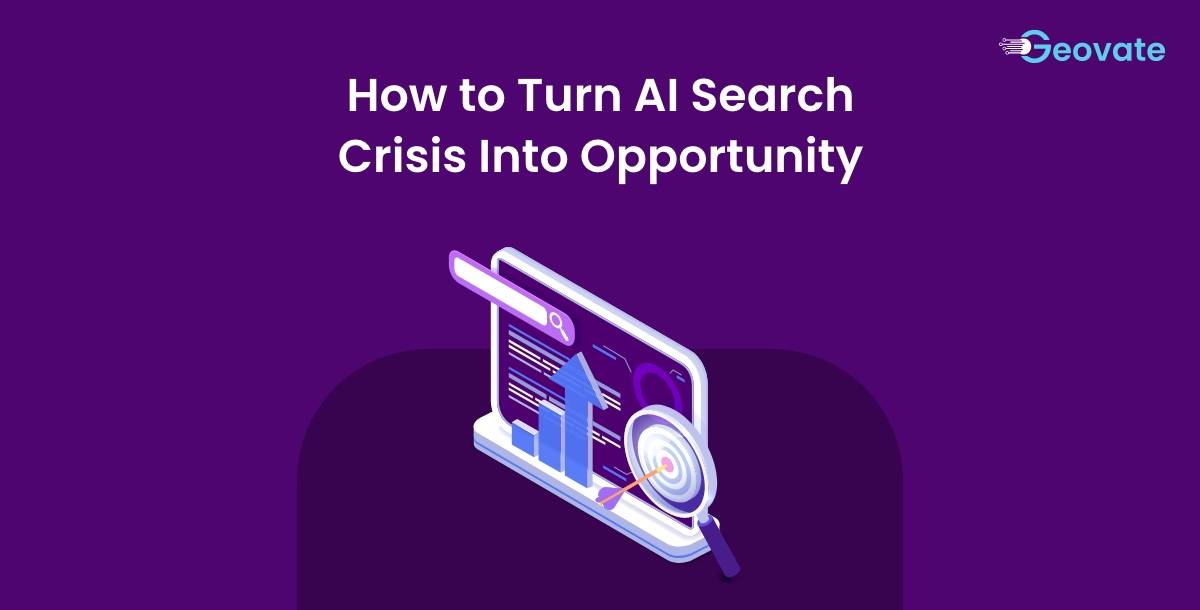How to Turn AI Search Crisis Into Opportunity: Guide 2025
Wed,19 Nov 2025 16:06:00- Font Size
- Share Content

Search as we know it is changing—faster than at any point in the last 20 years. AI-powered search engines like ChatGPT Search, Perplexity, Google AI Overviews, and Gemini are rapidly reshaping how users discover information. These tools deliver instant answers, summarize webpages, and often remove the need for users to click through to a website at all.
That shift has created what many marketers call an AI search crisis: declining traffic, lower click-through rates, and the collapse of traditional top-of-funnel (TOFU) keyword strategies.
But here’s the truth:
AI search isn’t a crisis—it’s an opportunity for brands that adapt early.
This comprehensive guide shows exactly how any brand (in any industry) can evolve its content strategy, strengthen visibility, win AI citations, and turn fewer clicks into more conversions.
Understanding the AI Search Shift
For decades, SEO was built on ranking webpages on Google’s blue-link results. Ranking high meant visibility, traffic, and leads.
AI search has changed that ecosystem:
- Users now get instant answers without clicking.
- AI summarizes TOFU informational queries.
- Only the most structured, authoritative content gets cited.
- Search engines are transforming into answer engines.
- Traffic is compressing, especially at the awareness level.
This has led many businesses to panic as they see analytics dashboards showing declining sessions.
But focusing only on traffic misses the point. AI search rewards brands that offer:
- Clear, structured, extractable insights
- Expert authority
- Decision-stage content
- Case studies, comparisons, and actionable frameworks
- Schema-backed content
- Strong topical authority
This is your moment to shift from a traffic-only strategy to a conversion and authority-driven strategy.
Why the AI Search Crisis Is Really an Opportunity
Traffic is no longer the most important KPI—qualified intent is.
Instead of chasing millions of impressions, AI search pushes brands to create content that:
- Attracts ready-to-buy users
- Solves specific pain points
- Builds trust and expertise
- Gets cited by AI assistants
- Converts more effectively
In other words:
You lose some low-quality traffic but gain high-quality buyers.
This is exactly where the opportunity lies.
How to Rebuild Your SEO Strategy for AI Search
1. New Content Strategy: From Volume → Intent
The first shift is moving from content quantity to content intent. Traditional SEO rewards massive content libraries with hundreds of keyword-focused TOFU articles.
AI search no longer rewards this approach.
Focus on Mid- and Bottom-Funnel Content
TOFU content is easy for AI models to summarize. But MOFU and BOFU content is harder to compress and more valuable to buyers.
Examples:
MOFU (Consideration) Content
- Comparison guides (A vs B)
- Alternatives lists
- Buyer’s guides
- Industry frameworks
- Problem-solution articles
- In-depth tutorials
BOFU (Decision) Content
- Case studies
- Pricing pages
- Testimonials
- Implementation guides
- ROI breakdowns
- Service/product landing pages
These content types attract people who are close to taking action—and AI models often highlight them because they contain unique value not found elsewhere.
Incorporate Answer Engine Optimization (AEO)
Answer Engine Optimization (AEO) means optimizing your content not just for Google but for AI assistants that extract and cite content.
To make your content extractable:
- Use H2 and H3 headings that mimic search questions.
- Provide short, direct answers at the top of each section.
- Use clear lists, bullets, and numbered steps.
- Add FAQs with schema markup.
- Insert concise definitions.
- Add expert quotes with credentials.
- Maintain strong logical flow.
Example:
What Is the Main Risk AI Search Poses to Websites?
The biggest risk is a decline in top-of-funnel traffic as AI summarizes informational queries and answers them without user clicks.
This sentence is highly extractable for AI summaries.
Map Your Content to User Intent
A powerful AI-era content strategy requires perfect alignment with user intent. Here’s the universal mapping:
Funnel Stage | Intent | Content Type |
|---|---|---|
TOFU – Awareness | “What is…” | Definitions, guides, stats |
MOFU – Consideration | “Is this right for me?” | Comparisons, alternatives, checklists |
BOFU – Decision | “Should I buy?” | Case studies, pricing, landing pages |
Ensure your website has balanced coverage across all three.
2. On-Page SEO & Technical Optimisation
AI models prefer content that is structured, consistent, and technically sound.
Here’s how to strengthen your pages.
Use Schema Markup Everywhere It Makes Sense
Schema helps AI assistants interpret your content accurately.
Use:
- FAQ schema
- HowTo schema
- Article schema
- Product/service schema
This improves your chance of appearing in:
- AI-generated answers
- Featured snippets
- People Also Ask (PAA)
- Google’s rich results
Build Topic Clusters and Pillar Pages
A topical cluster includes:
- One pillar page (broad, comprehensive)
- Multiple cluster pages (specific subtopics)
- Interlinking between all pages
This builds:
- Domain authority
- Relevance
- Better crawling
- Stronger context for AI models
AI assistants rely heavily on topical depth to judge credibility.
Refresh and Optimise Older Content
Many brands have hundreds of outdated blogs that are still being crawled by AI systems. Refreshing them with:
- Updated statistics
- Better structure
- More internal links
- Improved clarity
- Stronger E-E-A-T signals
- Fresh examples
…can dramatically boost your visibility.
Expand Content with Extractable Elements
Add:
- Summary boxes
- Key takeaways
- Q&A sections
- Comparison tables
- Steps/process lists
- Checklists
These are often lifted directly by AI engines.
3. Modern SEO Measurement & KPIs
Traffic is no longer the most accurate measure of success.
Here’s what to measure instead.
TOFU Metrics
- Featured snippets
- AI citations (where identifiable)
- Organic visibility score
- Brand search volume
MOFU Metrics
- Clicks on comparison pages
- Time on page
- Scroll depth
- Pages per session
- Return visits
BOFU Metrics
- Conversion rate
- Form submissions
- Phone calls
- Demo requests
- Time-to-close
- Lead quality
Set Realistic Timeframes
Content improvements, especially at the mid- and bottom-funnel, take 3–6 months to impact revenue.
Measure each funnel stage separately rather than treating all content equally.
4. Content Structure, Tone, and Voice
Your content must be written for two audiences:
- AI systems, which look for structure
- Human buyers, who need trust and clarity
To satisfy both:
Adopt an Expert, Authoritative Voice
Back up claims with:
- Data
- Industry examples
- Expert quotes
- Research
- Internal experience
This boosts E-E-A-T and makes your content more trustworthy for AI extraction.
Use “People Also Ask” Style Questions as Headings
AI assistants love these because they read just like user intent queries.
Examples:
- Why Is AI Search Reducing Web Traffic?
- How Can Brands Get Cited in AI Answers?
- What Is AEO and Why Does It Matter?
Use Visuals for High Extractability
Tables, checklists, and frameworks are particularly effective.
Example comparison table:
Strategy | Old SEO | AI-Era SEO |
|---|---|---|
Focus | Traffic | Intent & authority |
Content | High volume | High relevance |
Structure | Basic H2s | Extractable Q&A |
KPIs | Sessions | Conversion & citations |
Include Case Studies Wherever Possible
Case studies are:
- Unique
- Hard to summarise
- Highly valuable
- Conversion drivers
They help with BOFU visibility and AI trust signals.
Conclusion: AI Search Is Not the End of SEO—It’s the Evolution
The shift to AI-powered search is undeniable—but it is not something to fear.
Brands that adapt will:
- Lose low-quality traffic
- Gain high-quality leads
- Build deeper authority
- Earn AI citations
- Convert more customers
SEO isn’t dying.
It’s evolving into a more strategic, intent-led, AI-conscious discipline. This is the largest opportunity in years for brands willing to evolve.
Frequently Asked Questions
Q1. How do I optimize my content for AI search engines?
To optimize for AI search engines, structure your content with clear headings, add concise answer summaries, use schema markup, include expert quotes, and focus on MOFU/BOFU content that provides depth, insights, and decision-focused value.
Q2. How can my website get cited in AI-generated answers?
Your site gets cited when AI can extract clear, authoritative statements. Add structured FAQ sections, definitions, data-backed insights, and strong E-E-A-T signals. Ensure content is fresh, factual, and easy for AI to summarize.
Q3. How does AI search impact traditional keyword strategies?
AI search reduces the effectiveness of high-volume TOFU keywords because AI tools summarize them directly. This shift pushes brands to create intent-driven content—comparisons, alternatives, case studies, and buyer guides—that cannot be compressed easily.
Q4. Why is my organic traffic dropping even though I still rank on Google?
Traffic is dropping because AI Overviews, ChatGPT Search, and Perplexity answer queries without requiring clicks. Users get their answers instantly, so impressions remain high, but CTR and sessions decrease. This is a normal result of AI-led search behavior.
Q5. How can brands stay visible when AI reduces clicks?
Brands can stay visible by focusing on extractable insights, strengthening topical authority, using schema, publishing decision-stage content, and updating older articles. The goal is to be cited in AI answers—not just ranked in blue-link results.
